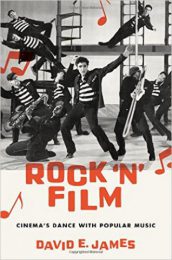While already in the 1940s the Hollywood musical artistically integrated film, acting, dancing and singing, it also had another very important feature. „With sound, the movies had become the major means of disseminating popular songs, both those composed for Broadway musicals that were subsequently filmed and those written by the studio’s own teams of lyricists.“
 In this manner, the number of all songs used in Hollywood films until 1990 is estimated to be 25,000 alone.
In this manner, the number of all songs used in Hollywood films until 1990 is estimated to be 25,000 alone.
The genre of the musical was heavily altered with the advent of the rock’n’roll musical, which at first was very similar in structure to the original musical. And so were the many teenage love stories that were surfacing from the mid-1960s onwards. This includes the various movies that had only little (serious) plot, but presented a prominent pop singer, like Elvis, the Beatles or others instead.
James approaches the various collaborations of (rock) music and film from a very theoretical point of view with theories and tactics successfully borrowed from academic disciplines such as media studies, sociology, and American Studies. This unmistakably distinguishes his work from other, mere genre-based collections of musicals and rock films. (Nevertheless, his surveys of country music films and revues, blaxploitation and festival movies are highly recommendable).
Films with/about music also have a number of functions that are unveiled only at second glance: “As they [the films that feature the spectacle of musical performance] document its fans’ use of it, how and what they make it mean and how they articulate it with other activities – those immediately adjacent to it like dance, but also everyday life in general – rock’n’roll films also have the pedagogic function of disseminating and popularizing these practices, or of teaching others how to rock’n’roll. … As much as reviewers and other journalistic media and sociological and other academic projects, cinema’s stories about rock’n’roll elaborate and interpret the music’s aesthetic and social meanings …. Debating and projecting, attacking and justifying these meanings, cinema makes them sensually present and ideologically resonant. In narrating rock’n’roll, cinema theorizes it.”
Of the numerous movies, rock’n’roll musicals, revues, music documentaries, rock festival movies, musician biopics, and shows that are subject to the study, here is a very short excerpt: movies featuring The Beatles, Elvis and The Rolling Stones, American Graffiti, The Band Wagon, Blackboard Jungle, Beat Girl, That’ll Be The Day, The T.A.M.I. Show, The Big T.N.T. Show, Catch Us If You Can, Music City U.S.A., Don’t Knock the Rock, Flame, Head, The Girl Can’t Help It, Kansas City, Las Vegas Hillbillies, Lady Sings the Blues, Nashville, Quadrophenia, Tonite Let’s All Make Love in London, Ziggy Stardust and the Spiders from Mars, Payday and many others.
Jones emphasizes the power some music films have (or once had), since they often reflect some sociological and political consensus that was most common at the time of the movies’ production; nevertheless, the combination of this approach together with the music of the film may give way to an entirely different perception of the movie only a decade later.
This naturally is influenced by styles of film making: “Finally, the representation of the meanings of music in cinema is also shaped by the mode of the film’s own production, for just as at a given time music as a whole includes various modes of musical production, cinema includes multiple modes of film production.”
Other difficulties in interpreting the subject of musicals, musical movies, rock documentaries are created by the mere mass of films.
James, Professor of Cinematic Arts at the University of Southern California, does a good job of highlighting the main influences, most important movies and techniques used by mostly American and British directors who in turn influenced later productions. “The corpus of rock’n’roll films, especially as it appears in the alphabetized lists of popular guides, may seem a directionless miscellany, with none of the generic consistency and stability of the classic musical. … From the mid-1950s to the mid-1970s, rock’n’roll films narrated a myth of the contested emergence, maturation, and eventual decline of a fundamentally biracial cultural initiative that accompanied sustained and in some ways preceded the utopian politics of the same period. Cinema and rock’n’roll, musicality in the former and visuality in the latter, engaged in a complex dance: a pas de deux of approach, retreat, struggle for mastery, and virtuous turns, with the one variously elaborating or challenging the other.”
This is a remarkable title and I would not be surprised to find it cited as a standard volume on pop music-and-film in the years to come.
Review by Dr. A. Ebert © 2016
David E. James. Rock ‘N’ Film. Cinema’s Dance With Popular Music. Oxford University Press, 2016, 470 p.
